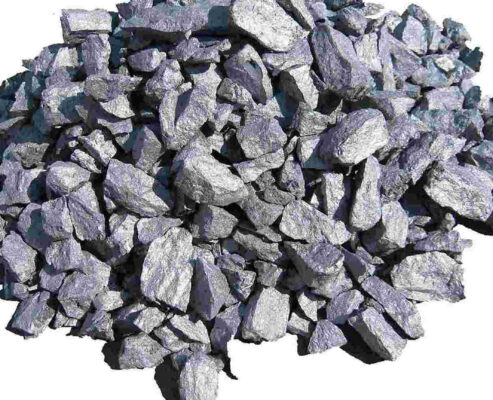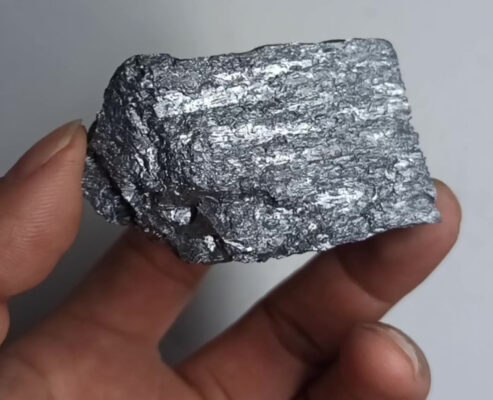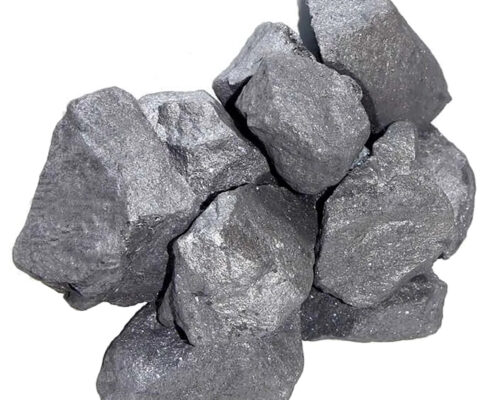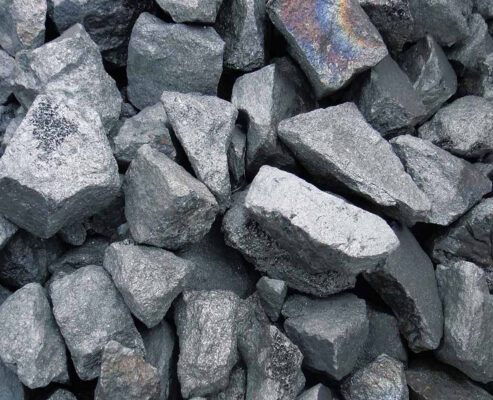Ferro Silicon Manganese (SiMn)
Composition:
Ferro silicon manganese (SiMn) is not a single compound, isn’t found naturally in Egypt or anywhere else on Earth. It’s an alloy produced through industrial processes that combine manganese, silicon, and iron. but an alloy composed primarily of three elements:
Manganese (Mn): Typically ranging from 55% to 75% by weight. Manganese acts as a deoxidizer and alloying element, improving steel’s strength, toughness, and hardenability.
Silicon (Si): Typically ranging from 15% to 35% by weight. Silicon acts primarily as a deoxidizer, removing oxygen from molten steel and forming harmless slag.
Iron (Fe): The remaining portion, often referred to as “balance” This iron contributes some deoxidizing effect but mainly serves as a diluent and carrier for the manganese and silicon.
The specific proportions of Mn, Si, and Fe can vary depending on the desired final properties of the steel being produced.
Crystal Structure:
The crystal structure of SiMn is complex due to its multi-component nature. It’s a mixture of different phases depending on the composition and cooling history. The main phases include:
• Face-centered cubic (FCC) iron (α-Fe): This phase dominates at high temperatures and provides the base structure for the alloy.
• Manganese carbide (Mn3C): Hard and brittle phase that can improve wear resistance but needs careful control to avoid embrittlement of the steel.
• Iron silicides (FeSi): Contribute to deoxidation and can influence grain size and hardenability.
Ferro Silicon Magnesium Specification
| Constituents | PCT |
| MN | 65 % Min |
| C | 2 % Max |
| SI | 15 % Min |
| P | 0.25 % Max |
| S | 0.02 %Max |
Size distribution:
| Size | 10 – 60 mm 90 % |
Physical Properties:
• Melting point: Around 1200-1300°C (depending on composition)
• Density: Around 7.0 – 7.8 g/cm³ (denser than pure iron)
• Electrical conductivity: Lower than pure iron due to the presence of manganese and silicon
• Magnetic properties: Varies depending on composition. Can be weakly ferromagnetic due to manganese content.
Chemical Properties:
• Deoxidation: Both manganese and silicon readily react with oxygen in molten steel, forming oxides (MnO and SiO2) that rise to the slag layer.
• Alloying: Manganese and silicon influence the mechanical properties of steel. Manganese increases strength and hardenability, while silicon can improve strength and corrosion resistance.
Advantages of SiMn:
• Cost-effective: Provides a good balance of manganese and silicon content at a competitive price compared to using separate ferro manganese and ferro silicon.
• Versatility: Applicable to a wide range of steel grades due to the adjustable composition.
• Improved deoxidation: The deoxidation products (MnO and SiO2) tend to be more fluid compared to some alternatives, allowing for easier slag removal.
Limitations:
• Limited control over individual elements: The composition of SiMn is predetermined, offering less flexibility in fine-tuning the final steel properties compared to using separate ferroalloys.
Synthetic Information:
Ferro silicon manganese (SiMn) is an alloy, meaning it’s a metal mixture. The main components are manganese (Mn), silicon (Si), and iron (Fe). SiMn is a workhorse in steel production.
• Deoxidizer: Both manganese and silicon have a strong attraction to oxygen (deoxidizers). They remove oxygen from molten steel, leading to cleaner and stronger steel. SiMn’s deoxidation products are easier to remove compared to some alternatives.
• Alloying element: Manganese and silicon influence the properties of steel such as strength, toughness, and corrosion resistance. The amount added and interaction with other elements affect the final properties.
• Cost-effective: SiMn offers a good balance of manganese and silicon content at a competitive price compared to using separate ferro manganese and ferro silicon.
Production:
SiMn is produced by smelting manganese ore, coke (carbon source) and quartz (silicon source) in a submerged arc furnace at high temperatures. There are also variations made from recycling manganese slag.
SiMn is produced in submerged arc furnaces using high temperatures. The main raw materials include:
• Manganese ore: Source of manganese (Mn).
• Coke: Provides carbon (C) for the reduction process.
• Quartz (SiO2): Source of silicon (Si).
The high temperatures allow for the reduction of manganese and silicon oxides from the ores and their subsequent alloying with iron.
Applications:
SiMn is a crucial material in steelmaking due to its combined deoxidation and alloying effects. Here are some key applications:
• Stainless steel (200 series): Improves strength and workability.
• Alloy steel: Enhances hardenability and toughness.
• Manganese steel: Increases strength and wear resistance in applications like grinding media balls.
• General carbon steel production: Used throughout the steelmaking process for deoxidation and basic property improvement.
Comparison to alternatives:
• Ferro manganese (FeMn): Higher manganese content, lower silicon. Used when low silicon content is desired in the steel. Often an input material for SiMn production.
• Ferro silicon (FeSi): Primarily silicon for deoxidation. Can be partially replaced by SiMn in some applications.
Please Submit your inquiries




